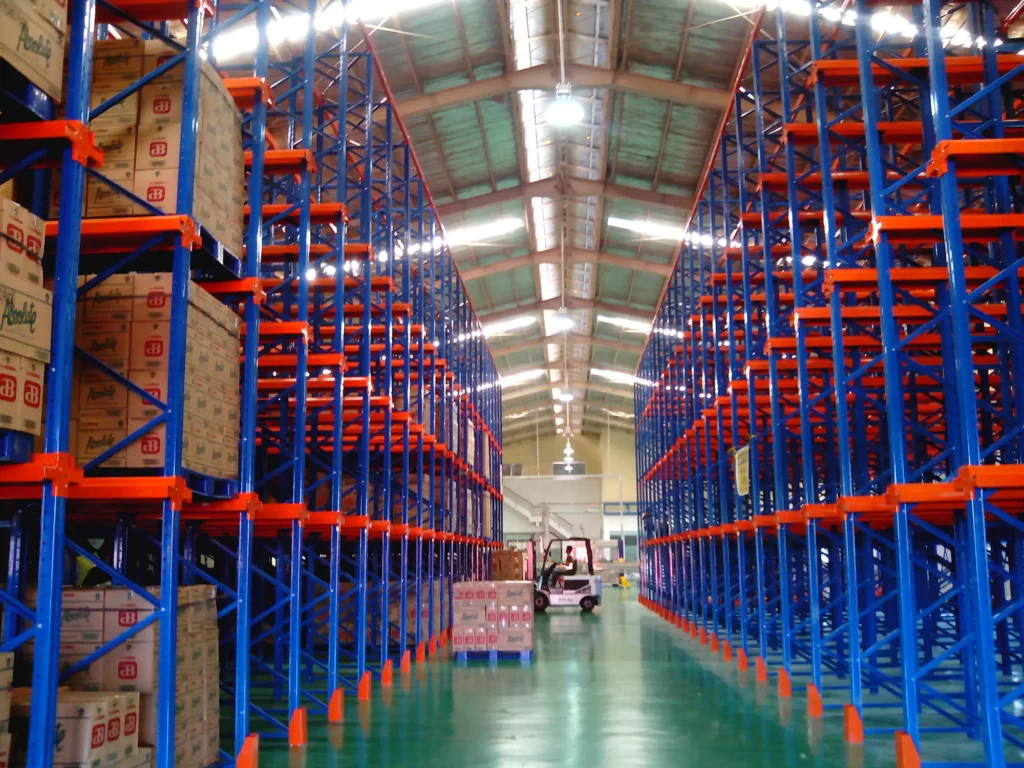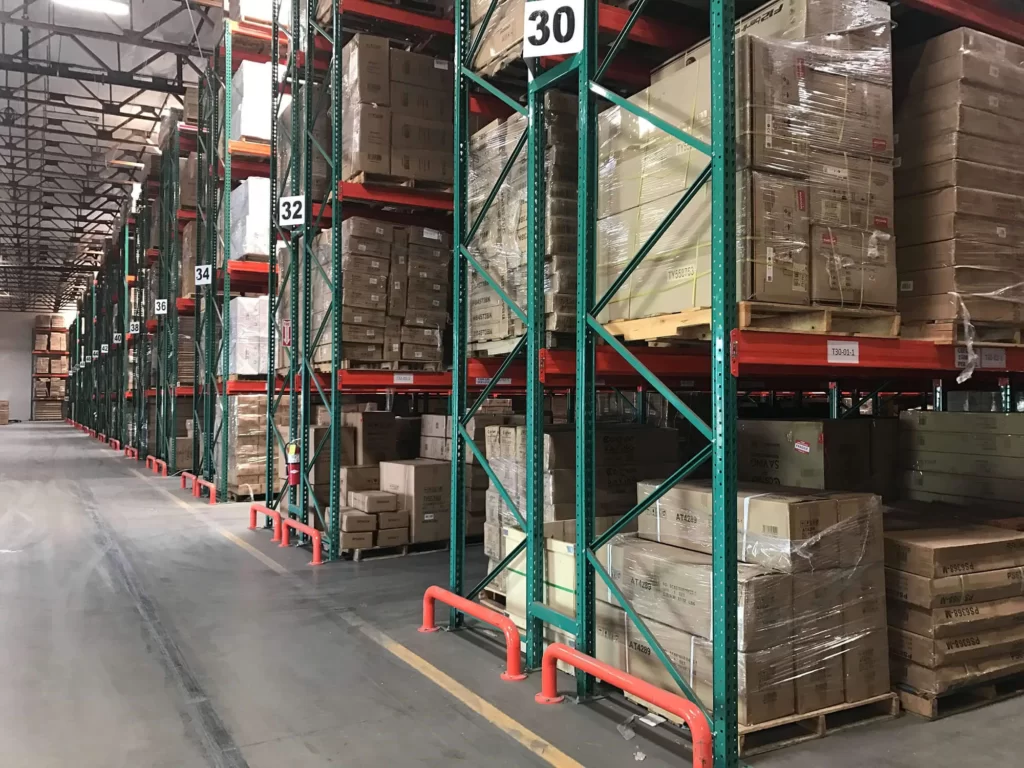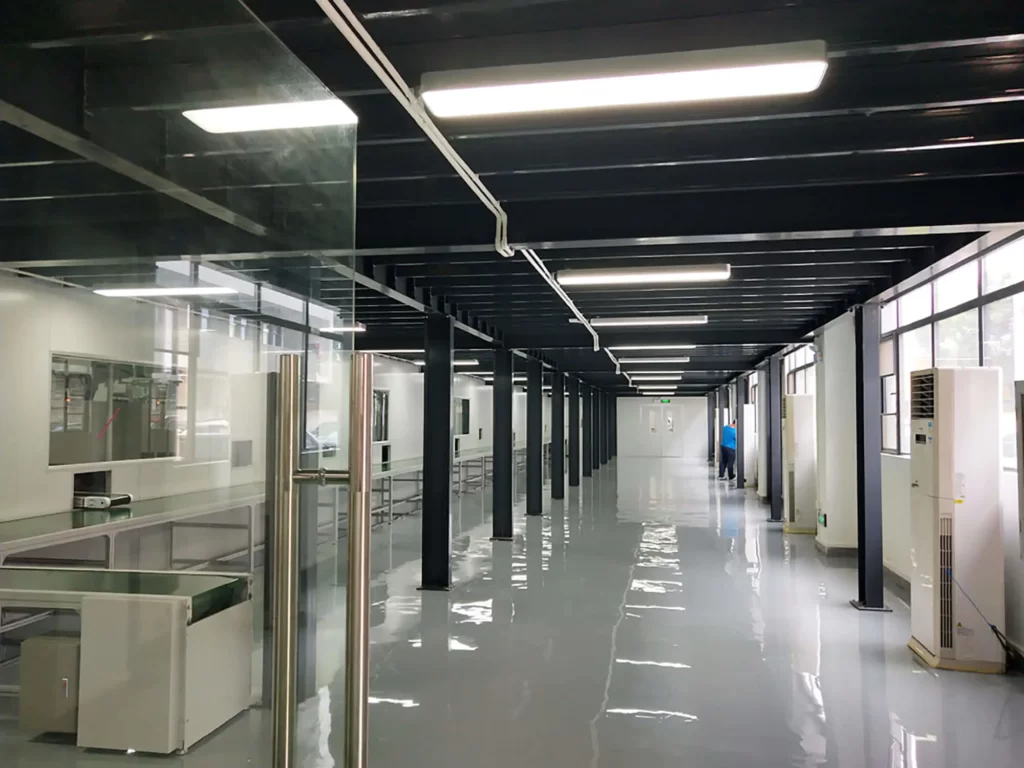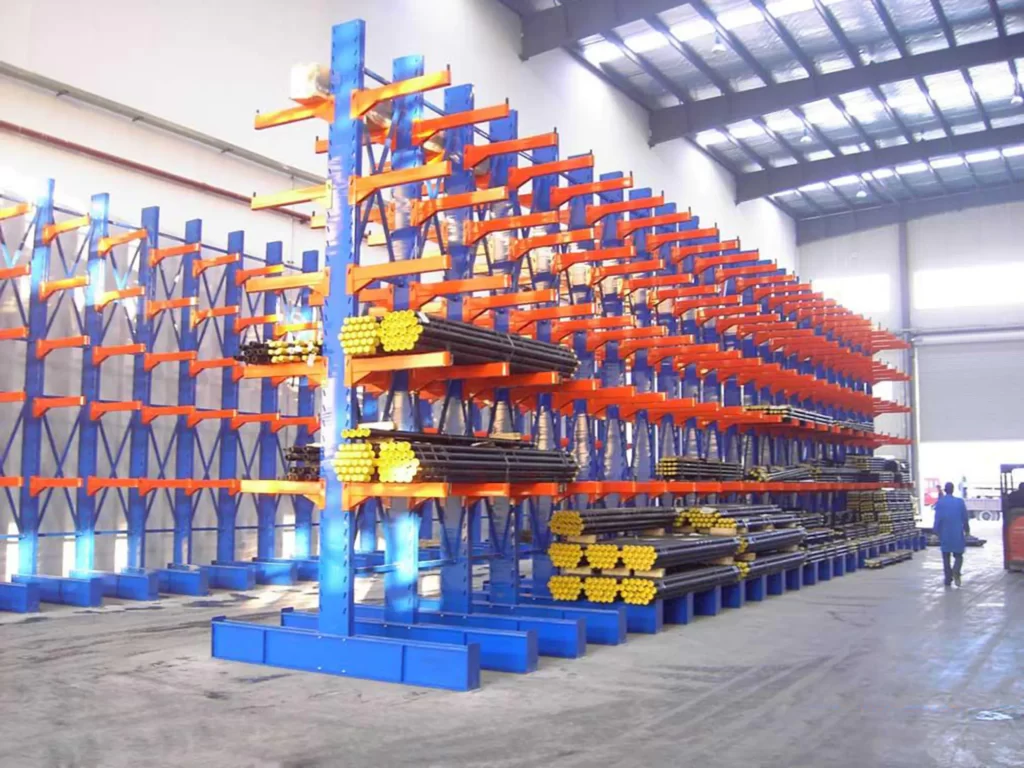Keeping long and bulky products organized proves difficult. The incorrect choice of cantilever rack arms leads to space inefficiency and creates unsafe storage conditions. Arms that do not fit well will not handle heavy items securely and will let items fall. Your warehouse performs less effectively and presents safety threats when you use unsuitable cantilever rack arms. Correctly installed cantilever rack arms create better storage by saving space while making items easier to reach and safer to handle. This guide explains the different cantilever rack arm types and helps you select the best storage solution. Let’s get started!
Understanding Cantilever Rack Arms
Cantilever rack arms help store long and heavy materials such as wood planks, metal rods, and metal plates. The vertical posts support long cantilever arms that let you store items openly from all angles. Workers can move materials into and out of the system using either forklifts or manually. These arms support several types of loads including thin tubing and robust steel pieces. Cantilever systems provide warehouses and distribution facilities better handling options than pallet racks because they can store large products.
Key Factors Affecting Cantilever Rack Arm Selection
Choosing proper cantilever rack arm styles helps you save space and safeguard your items better. These criteria allow you to pick the correct cantilever rack arms for your needs.
Load Type & Weight Capacity
Each arm type handles specific weight ranges according to its specifications. Steel cantilever arms support heavy items while aluminum or composite arms manage lighter equipment. Keeping weights still on the rack is static loading while having a forklift move them with cargo is dynamic loading.
Arm Length & Adjustability
Having longer arms supports large object storage but creates risks for stable operations. You can easily adjust your storage systems when inventory dimensions fluctuate thanks to adjustable arms. The adjustable design lets you modify your setup without rebuilding the whole system.
Material & Durability
Aluminum supplies a weight-saving option while steel maintains its strength standards. The strength of composite materials stands against corrosion but weakens under extreme pressure. The steel arms of a storage system become rust-resistant by using galvanizing protection against wet and corrosive environments.
Environment & Application
Special techniques are needed for indoor spaces that you cannot use for open-air areas. Steel parts retain their operating strength thanks to the added weather protection layer that works well in rainy and chilly conditions. Materials that can endure corrosive damage work best when storing in chemically harsh areas.
Safety Features & Compliance
Choose materials that meet OSHA safety needs and ANSI equipment standards. Proper load labeling prevents overloading. Placing loads evenly across storage racks prevents accidents and keeps the racks working longer.
Arm Design & Load Distribution
Choose between standard and tilted loading arms based on your specific storing requirements. Straight-shaped arms work best for flat materials while incline arms keep things in place to stop them from sliding down.
Attachment & Locking Mechanisms
Fixed arm storage delivers solid support and detachable arms help simplify installation for various rack configurations. Fixed bolt security measures and locking pins safeguard assets while welded arm joints maintain strength in any weather.
Compatibility with Racking System
Ensure your new arms will work with your present stand and base parts. Better support tools need to hold heavy items safely without risk of damage.
Cost vs. Longevity
A steel arm’s higher upfront price extends its service life and saves money in the long run. Equipment durability increases and needs fewer fixes thanks to protective coatings which help parts last longer. When you choose steel arms their durability saves you money by reducing replacement costs.
Classification of Cantilever Rack Arms by Material
Stainless Steel Arms
The stainless steel arms display superior resistance to damage and corrosion protection. Stainless steel arms retain their strength under moisture exposure and resist chemicals plus extreme temperature fluctuations. You can commonly find these arms used in chemical plants and food and pharmaceutical production facilities because they resist corrosion and maintain high hygiene standards. Even though stainless steel arms are pricey their durability and easy care make them worth the higher initial cost.
Hot-Dipped Galvanized (HDG) Arms
HDG steel arms get their protection from a zinc layer that blocks corrosion and rust. HDG arms work best when protecting outdoor items from rain, humidity and temperature changes. Galvanized steel arms cost less but provide extended durability compared to stainless steel. People commonly use these arms in lumber yards to store wood products and in marine facilities to keep boats and ships safe.
Aluminum Arms
The light material and chemical resistance of aluminum arms makes them ideal for scientific laboratory applications. Warehouses generally avoid these arms because they can support less weight. You should choose aluminum when your application demands both corrosion protection and no magnetic response.
Classification Based on Load Capacity
Light-Duty Cantilever Arms
Each light-duty arm can handle loads within the range of 50 to 500 pounds. Their strength makes them excellent for placing PVC pipes, aluminum tubing and small wooden pieces in storage. These arms work well for businesses that need neat and easy ways to store delicate or lightweight materials.
Medium-Duty Cantilever Arms
These arms handle loading between 300 to 2000 pounds per arm. These systems can handle the weight of metal rods, plastic tubing and medium timber. This system strikes a good balance between load handling capacity and adaptability to serve construction and production enterprises.
Heavy-Duty Cantilever Arms
Heavy-duty cantilever arms handle materials weighing 600 to 4,000 lbs per arm. These supports can handle big items such as steel pipes, long timber pieces, and thick metal sheets. Built to withstand tough conditions these storage arms keep products safe while working well in industrial and warehouse spaces.
Classification by Arm Design
Straight Arms
A straight arm design produces a stable flat area for placing non-rolling items. These arms support flat materials such as wood panels and metal sheets. They help keep materials in place during storage and aid smooth stack placement. Choose straight arms based on their size and ability to resist bending. Heavy materials weigh down long arms which makes them unstable. Sturdy materials and evenly distributed loads make the structure last longer.
Inclined Arms
Inclined arms with a slight hill-like angle help keep cylindrical objects from sliding off. These arms are recommended for securing cylindrical parts like pipes, tubing, and rolls since they minimize movement. The system adjusts its slope settings for different load types to provide best stability results. Think about your stored item weights and dimensions when picking incline arms for storage. Placing items correctly on their supports stops them from sliding and helps users move items securely.
Customized Arms
Specialized arms help meet specific storage requirements through reinforced materials and adjustable parts plus different surface coverings. Companies that work with awkward or heavy materials need special equipment to handle them safely. Adjustable arms help users position items at different angles and powder coating or galvanization protects equipment against tough settings.
Rack Configuration and Arm Placement
Single-Sided Arms
Only one side of each rack upright holds cantilever arms extending outwards. They save floor space by storing items next to walls. Cantilever racks with single-sided arms help you store more items without creating walking obstacles. Storage facilities and workshop spaces mainly use cantilever supports to hold lumber, metal tubes, and flat materials.
Double-Sided Arms
Rack uprights support two cantilever arms that extend outward to create space for double the storage. This arrangement delivers maximum storage space for large warehouses that handle bulk goods. You can reach stored items from two sides which makes work faster. Double-sided racks use up more space but enable better storage positioning.
Specialized Cantilever Arm Types
Tapered Cantilever Arms
Tapered arms use a narrow shape to distribute weight better. The tapered design helps steady the rack system and protects it from damage. Most tapered arms feature welded or bolted lip attachments that keep stored items securely on the rack. These arms do their job best with loads of lengthy heavy stuff such as plumbing equipment and wood products.
Straight Cantilever Arms with Stop Features
These arms keep a steady width from base to tip. The final welded or bolted lips secure cargo from falling off. These arms provide optimal protection for materials that need secure storage options. The safety stops protect workers who work with metal sheets, rods and lumber in industrial settings.
Socket-Ready Cantilever Arms
You can personalize your socket-ready arms by swapping out stoppers or dividers. You can modify storage space settings to handle different materials. Their adjustable design works well in warehouses handling various products at once. They enable quick storage setup changes without long-term adjustments.
Bolt-On Arms
You can easily install and swap bolt-on arms into your rack system because they attach with bolts. Warehouses that demand regular updates and changes benefit from these storage arms. You should inspect bolt connections regularly because they need periodic tightening. Their flexible design makes bolt-on arms a top pick when storage requirements keep changing.
Welded Arms
The welded arm system offers long-term storage options because of its fixed design. They hold heavy weights securely through their stable design without needing periodic upkeep. These arms stay in place permanently and require professional assistance for replacement. Industries that require dependable long-term storage solutions should use these arms.
Decked Arms
The added surface support of decked arms lets them safely store small objects and unexpected shapes. You can select between wood, rubber and metal mesh when choosing decking materials. Industries like retail, automotive, and logistics benefit from these arms for organized, efficient storage.
Cantilever Arm Lengths and Capacities
| Sr. No. | Feature | Light Duty Cantilever Arms | Medium Duty Cantilever Arms | Heavy Duty Cantilever Arms | Industrial Grade Cantilever Arms |
| 1 | Length | 12″ – 24″ | 12″ – 48″ | 12″ – 60″ | 12″ – 60″ |
| 2 | Capacity (per arm) | 300 – 1000 lbs | 300 – 1,000 lbs (or more) | 600 – 4,000 lbs (or more) | 3,000 lbs (or more) |
| 3 | Material | Steel | Steel | Steel | Steel |
| 4 | Arm Type | Straight, Incline | Straight, Incline | Straight, Incline | Straight, Incline |
Factors Affecting Load Capacity
Arm Material
The load-holding capacity of structural steel arms increases because their solid reinforced construction provides strong support. Their strong design makes them perfect for handling heavy loads such as steel pipes and wooden planks. Steel arms made by bending thin sheets perform well with smaller items while carrying up to medium weights. These racks adjust well but handle lighter weights.
Arm Type
Single-sided metal arms attach to one side of the storage rack for wall installation. The rack features two sets of arms that extend from each side to create space for double storage. A double-sided rack system needs stronger foundations to stand firmly against heavy weights.
Arm Inclination
Flat materials such as wooden boards rest equally on straight arm supports. Inclined arm racks let tubes and pipes stay securely on their position because they don’t slide down. Selecting the best design makes items safer to handle and easier to find.
Why Load Capacities Vary: The Role of Finishes
Common Finishes for Cantilever Arms
Hot-Dip Galvanized Steel
Hot-dip galvanizing applies a protective zinc coating across steel surfaces. The material stands up strongly against rust and corrosion making it ideal for outdoor and demanding use. This material provides reliable stainless steel performance at lower costs.
Stainless Steel
Stainless steel resists harsh heat and chemical exposure without showing signs of wear. Different steel types possess different qualities so certain grades cannot be galvanized. You pay more for this material selection today but it delivers better chemical resistance and tolerance to high humidity for many applications.
Market Trends for Cantilever Rack Materials
Growth in Hot-Dip Galvanized Steel
Experts predict that hot-dip galvanized steel consumption will expand by 2.3% during the years 2021 to 2027. Companies choose galvanized steel because it gives better rust protection at a lower purchase price.
Stainless Steel Expansion
Stainless steel demand will expand by 6.8% every year between 2023 and 2032 according to projections. This material excels at challenging tasks thanks to its unbeatable strength which makes it stand out against other choices.
Regional Production Trends
China produces the biggest amounts of hot-dip galvanized steel to support worldwide manufacturing needs. Manufacturing companies rely on their selection of materials to produce items that withstand time and achieve desired outcomes.
Correct Loading Practices for Cantilever Arms
Stable cantilever arms need correct weight placement to stay in position and reduce the chance of damage. Implement these operational rules to keep your system running efficiently and working longer.
Preventing Load Deflection
Spread the weight evenly across all straight arms. Add extra arms when deflection happens to create stronger support. Unbalanced weight placement damages the system’s stability and may cause parts to fail.
Spacing and Overhang Limits
Position arms in pairs no more than half the load length apart for secure support. The load section should extend past the arms no further than half the distance between upright support columns. When spacing is incorrect and heights are too high the system’s weight-handling ability drops by 50% and creates increased danger of failure.
Avoiding Overloading Risks
Always review your cantilever system’s design limits before starting to load it. Share the weight between all arms to keep them from handling too much at once. When weight rests unevenly on the system parts they become more stressed and may bend or crack.
Securing Loads Against Movement
Install anti-roll-off tools to keep objects from falling off sloped arms. Straps and retainers hold materials in place that might move or stack unevenly. Security devices protect both employees and stored goods effectively.
Ensuring Stability with Vertical Alignment
Place heavy items near the upright frame to make handling easier. Stack lighter items on top of level arms to avoid accidents. Balancing weights correctly helps prevent system damage and keeps operations safe.
Protective Accessories for Cantilever Arms
Collision Guards
Your cantilever racks benefit from collision guards that shield against forklift collisions and unintended touches. L-shaped and U-shaped protectors connect to rack uprights and arms to shield them from damage. These protective guards keep your racks stable and reduce expenses on needed repairs.
Bridging Arms
Bridging arms create a horizontal connection between several cantilever arms. They enhance storage options by making it possible to hold long or flexible items securely. These supports help you build reliable platforms to hold metal sheets, wooden planks, and metal pipes safely.
Roll-Off Prevention Devices
End stops and pins on roll-off prevention devices keep materials on the cantilever arms safely secured. They help securely hold round and wobbly items such as tubes and pipes. These safety measures stop potential harm to workers and protect goods from damage.
Shelf Covers
The shelf cover creates a secure work space on cantilever support platforms. You can use grating shelves or chipboard plates across the arms to store small or oddly shaped items in all open areas.
Compartment Dividers
Compartment dividers organize multiple materials on the same rack level. These elements help arrange your goods properly while making the most of available space and helping you reach stored items fast.
Conclusion
Choosing appropriate cantilever rack arms provides safe and long-lasting storage solutions along with efficient space utilization. Each cantilever rack arm type has been designed to handle specific weight ranges and operational uses. Consider the weights you need to store when choosing material and length for your arms to save space and protect employees. A safe system relies on following industry rules plus spreading weight evenly across its structure. Determine your warehouse requirements to find arms that help you store better and work more efficiently over time.








